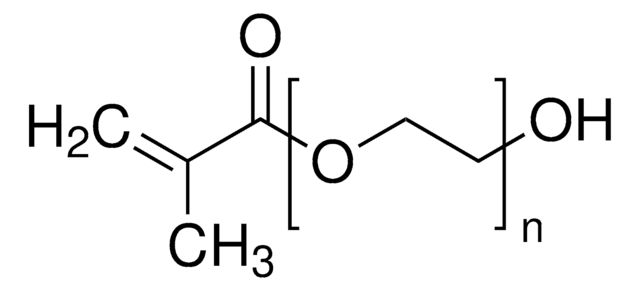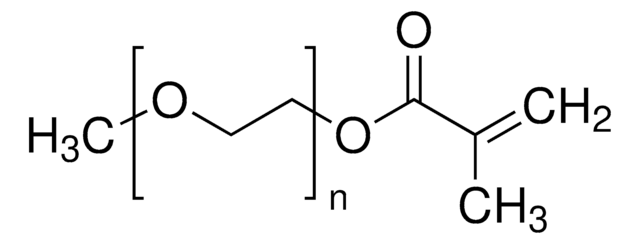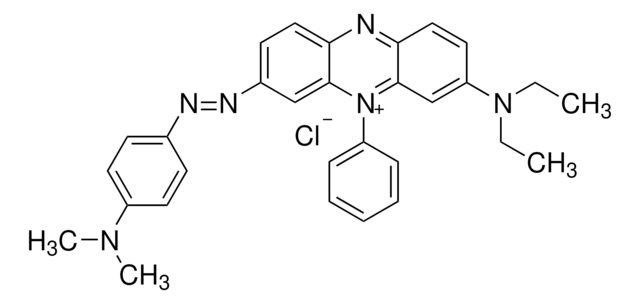Wichtige Dokumente
725692
Poly(ethylenglycol)-dimethacrylat
average MN 20,000, cross-linking reagent polymerization reactions, methacrylate, ≤1, 500 ppm MEHQ as inhibitor (may contain)
Synonym(e):
PEG-dimethacrylat
About This Item
Empfohlene Produkte
Produktbezeichnung
Poly(ethylenglycol)-dimethacrylat, average Mn 20,000, contains MEHQ as inhibitor
Form
powder
Mol-Gew.
average Mn 20,000
Enthält
MEHQ as inhibitor
≤1,500 ppm MEHQ as inhibitor (may contain)
Eignung der Reaktion
reagent type: cross-linking reagent
reaction type: Polymerization Reactions
bp
>200 °C/2 mmHg (lit.)
Übergangstemp.
Tm 59-64 °C
Mw/Mn
≤1.1
Ω-Ende
methacrylate
α-Ende
methacrylate
Polymerarchitektur
shape: linear
functionality: homobifunctional
Lagertemp.
−20°C
SMILES String
OCCO.CC(=C)C(O)=O
InChI
1S/C10H14O4/c1-7(2)9(11)13-5-6-14-10(12)8(3)4/h1,3,5-6H2,2,4H3
InChIKey
STVZJERGLQHEKB-UHFFFAOYSA-N
Suchen Sie nach ähnlichen Produkten? Aufrufen Leitfaden zum Produktvergleich
Verwandte Kategorien
Angaben zur Herstellung
Lagerklassenschlüssel
11 - Combustible Solids
WGK
WGK 1
Hier finden Sie alle aktuellen Versionen:
Analysenzertifikate (COA)
Die passende Version wird nicht angezeigt?
Wenn Sie eine bestimmte Version benötigen, können Sie anhand der Lot- oder Chargennummer nach einem spezifischen Zertifikat suchen.
Besitzen Sie dieses Produkt bereits?
In der Dokumentenbibliothek finden Sie die Dokumentation zu den Produkten, die Sie kürzlich erworben haben.
Kunden haben sich ebenfalls angesehen
Artikel
In this article, we will discuss the benefits and limitations of several 2D and 3D scaffold patterning techniques that can be applied in the presence of cells. Although these methods will be discussed in the context of poly(ethylene glycol) (PEG)-based hydrogels, they can technically be applied to any optically transparent, photoactive substrate.
The use of hydrogel-based biomaterials for the delivery and recruitment of cells to promote tissue regeneration in the body is of growing interest. This article discussed the application of hydrogels in cell delivery and tissue regeneration.
Progress in biotechnology fields such as tissue engineering and drug delivery is accompanied by an increasing demand for diverse functional biomaterials. One class of biomaterials that has been the subject of intense research interest is hydrogels, because they closely mimic the natural environment of cells, both chemically and physically and therefore can be used as support to grow cells. This article specifically discusses poly(ethylene glycol) (PEG) hydrogels, which are good for biological applications because they do not generally elicit an immune response. PEGs offer a readily available, easy to modify polymer for widespread use in hydrogel fabrication, including 2D and 3D scaffold for tissue culture. The degradable linkages also enable a variety of applications for release of therapeutic agents.
Unser Team von Wissenschaftlern verfügt über Erfahrung in allen Forschungsbereichen einschließlich Life Science, Materialwissenschaften, chemischer Synthese, Chromatographie, Analytik und vielen mehr..
Setzen Sie sich mit dem technischen Dienst in Verbindung.








